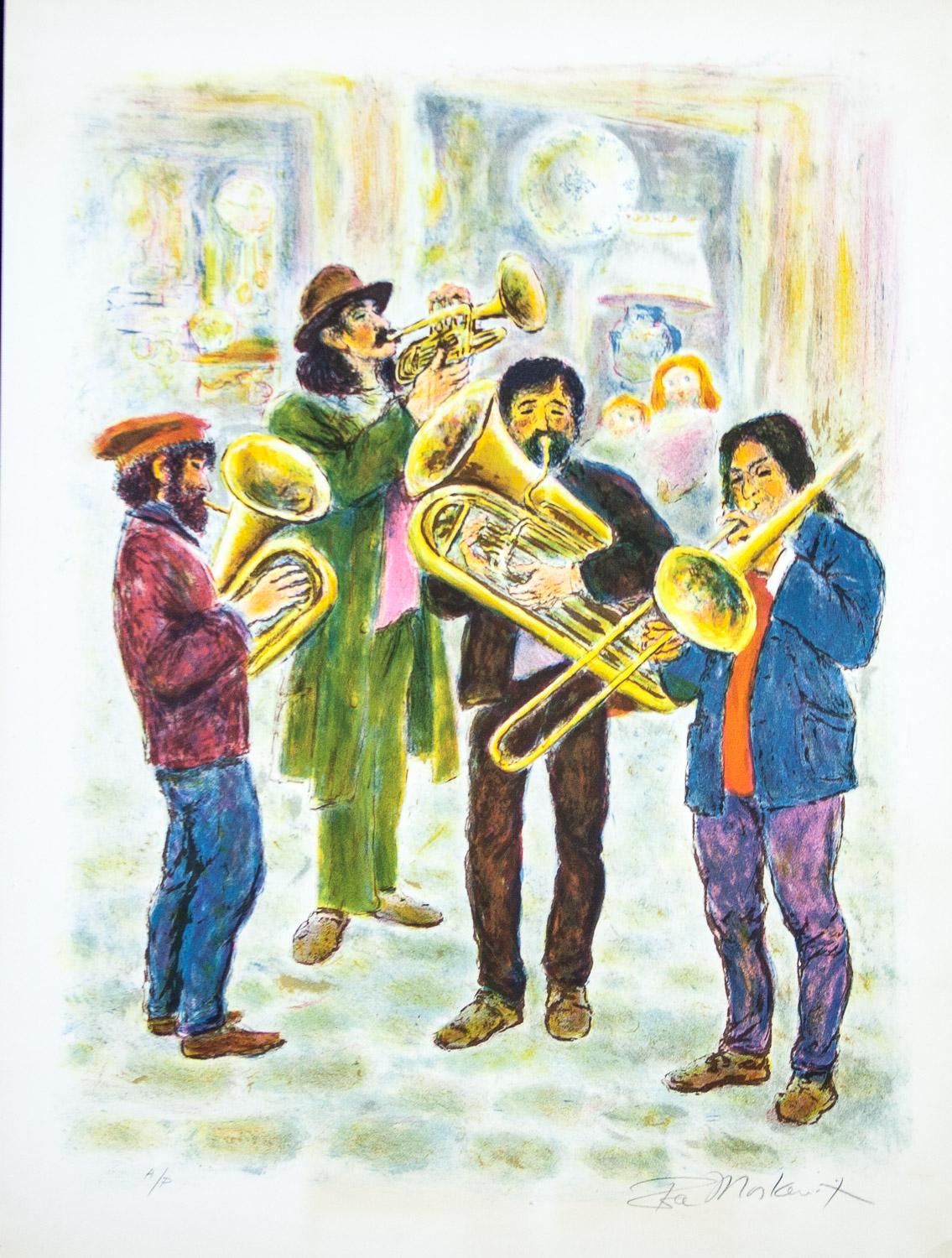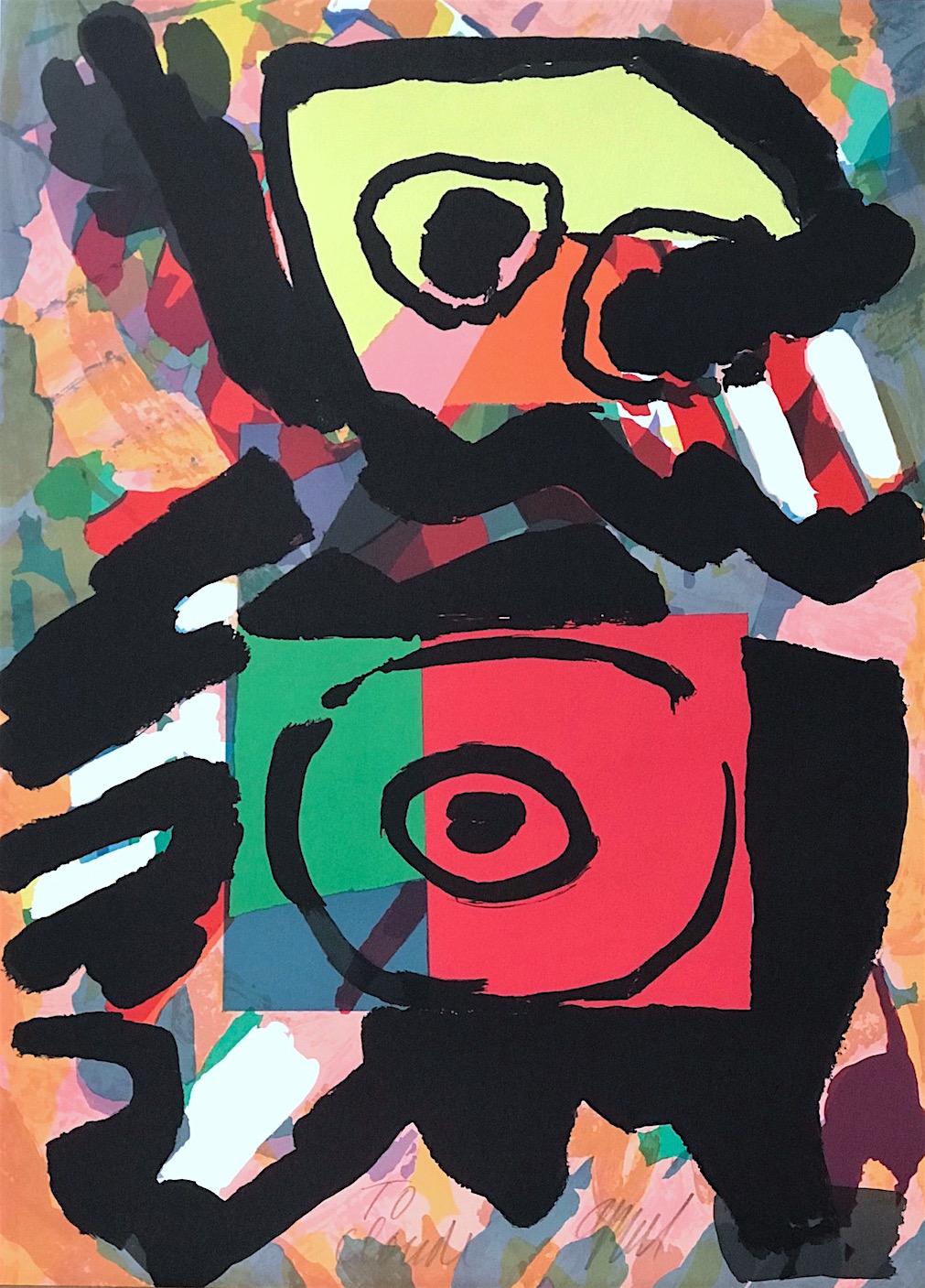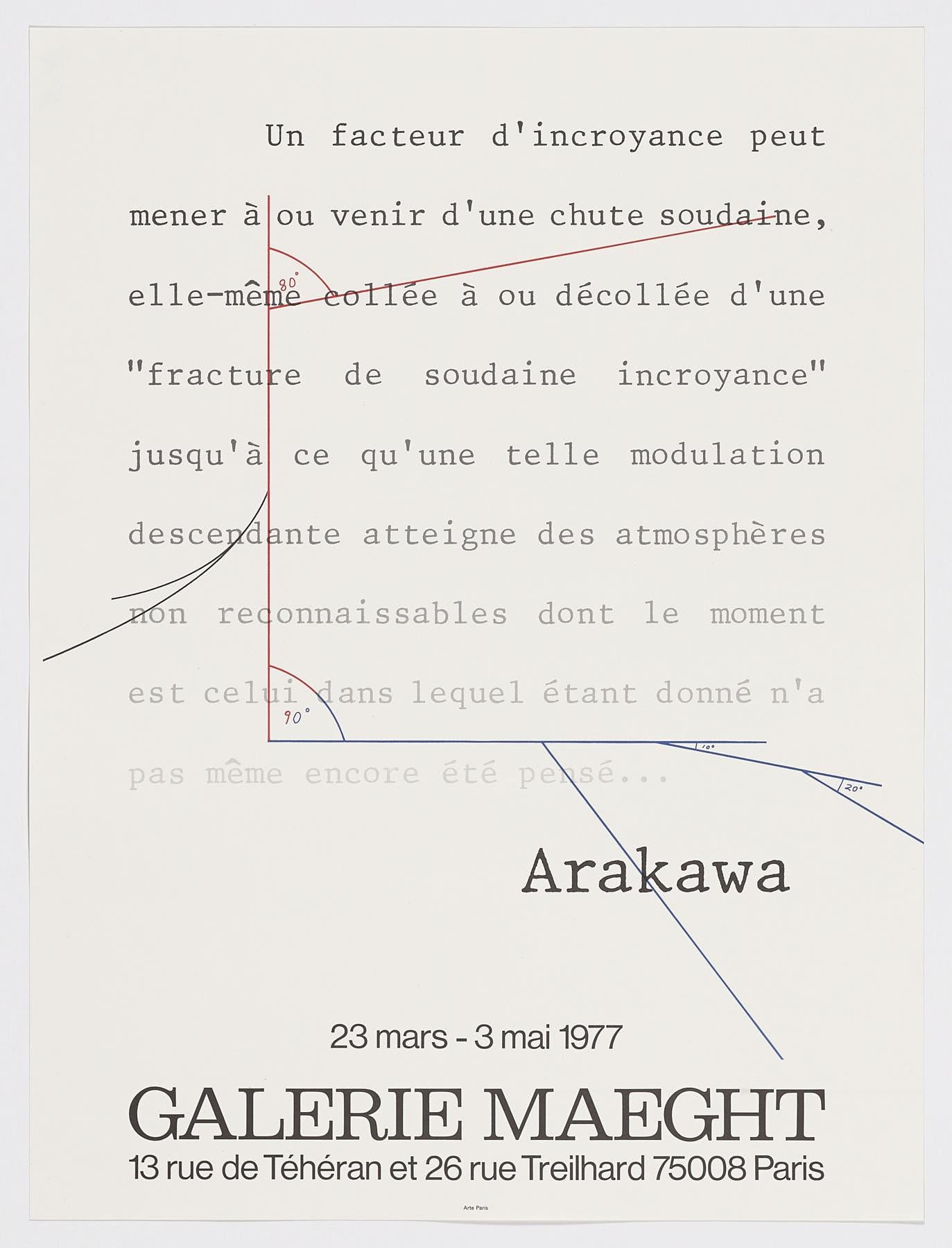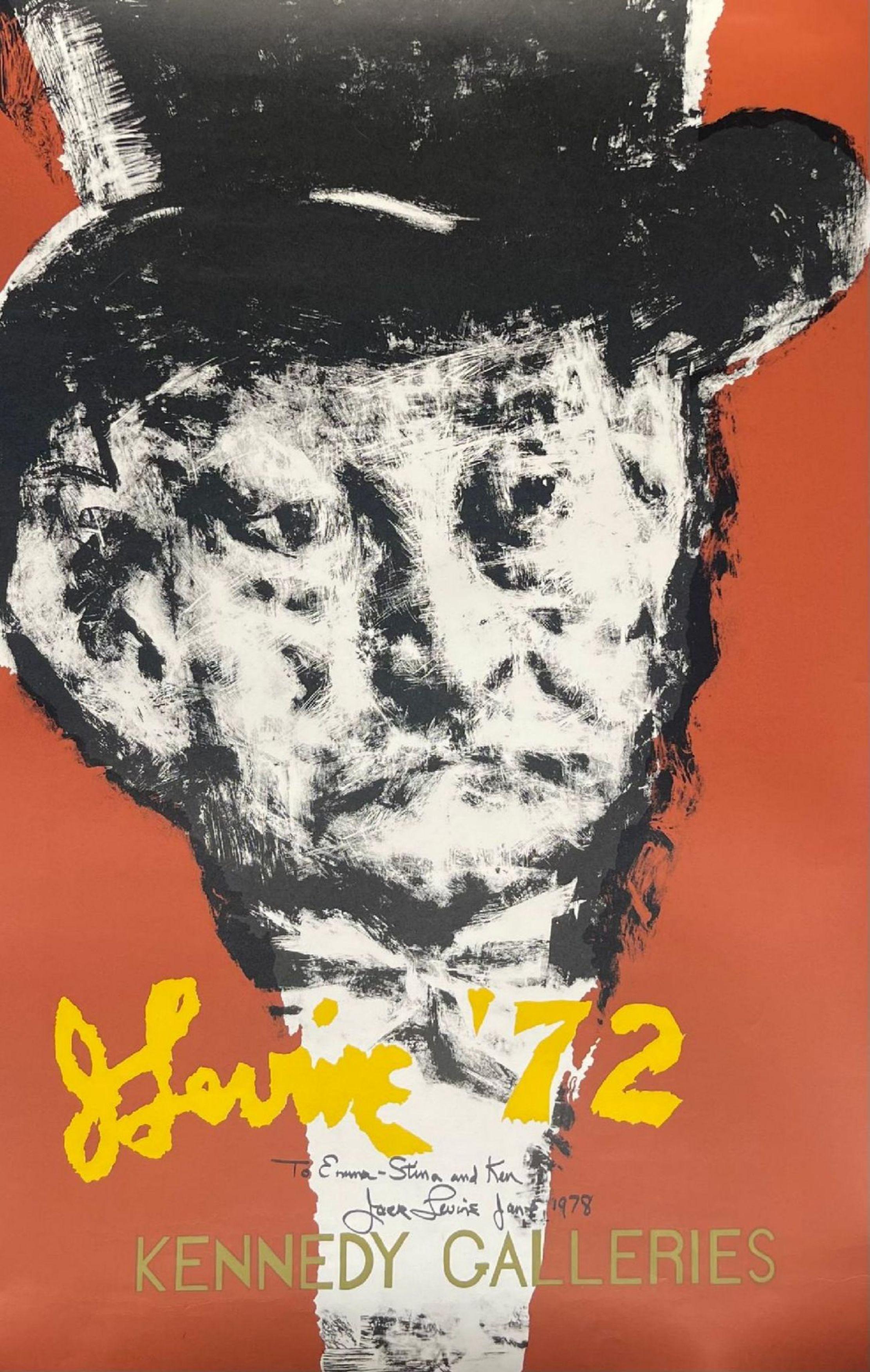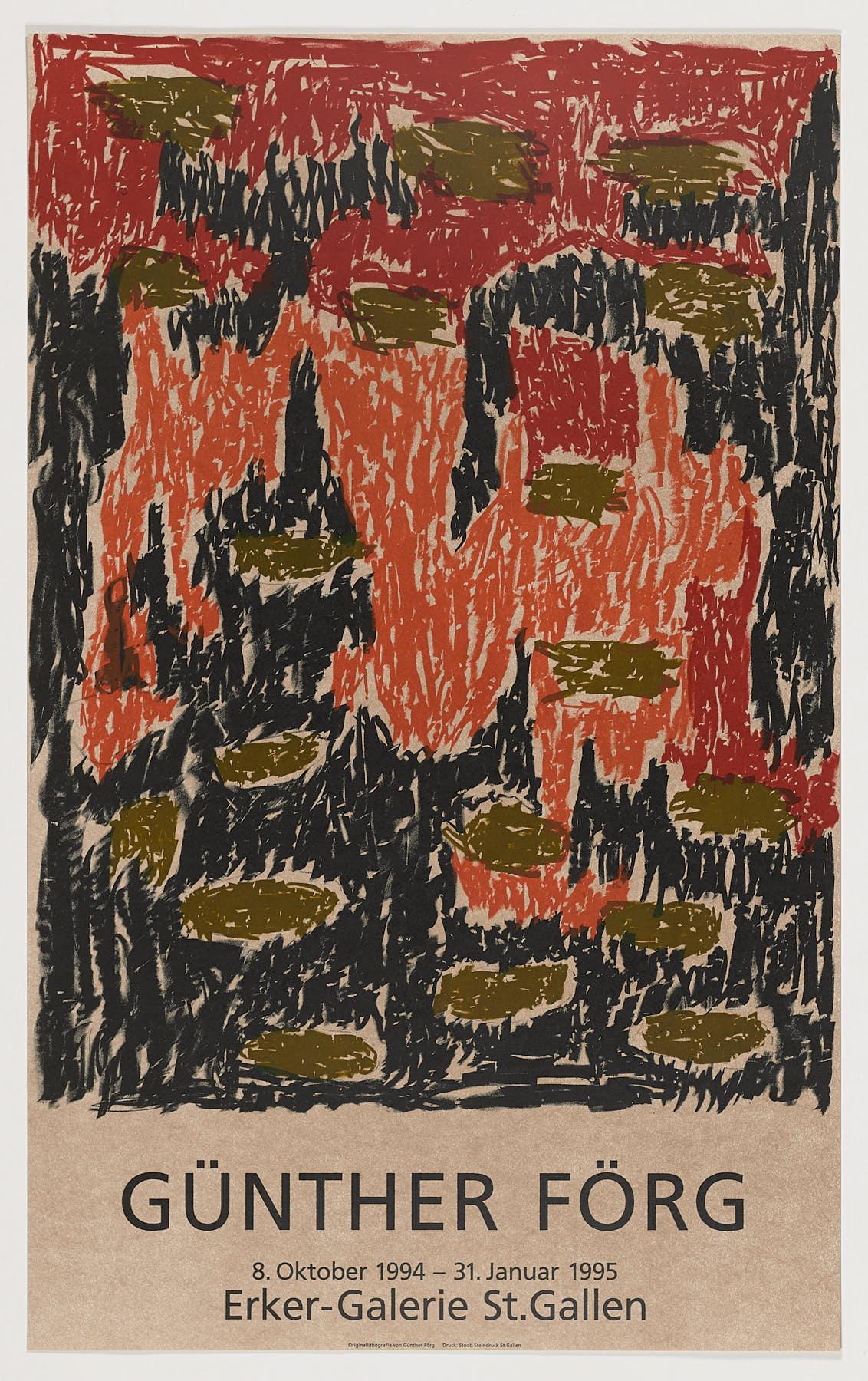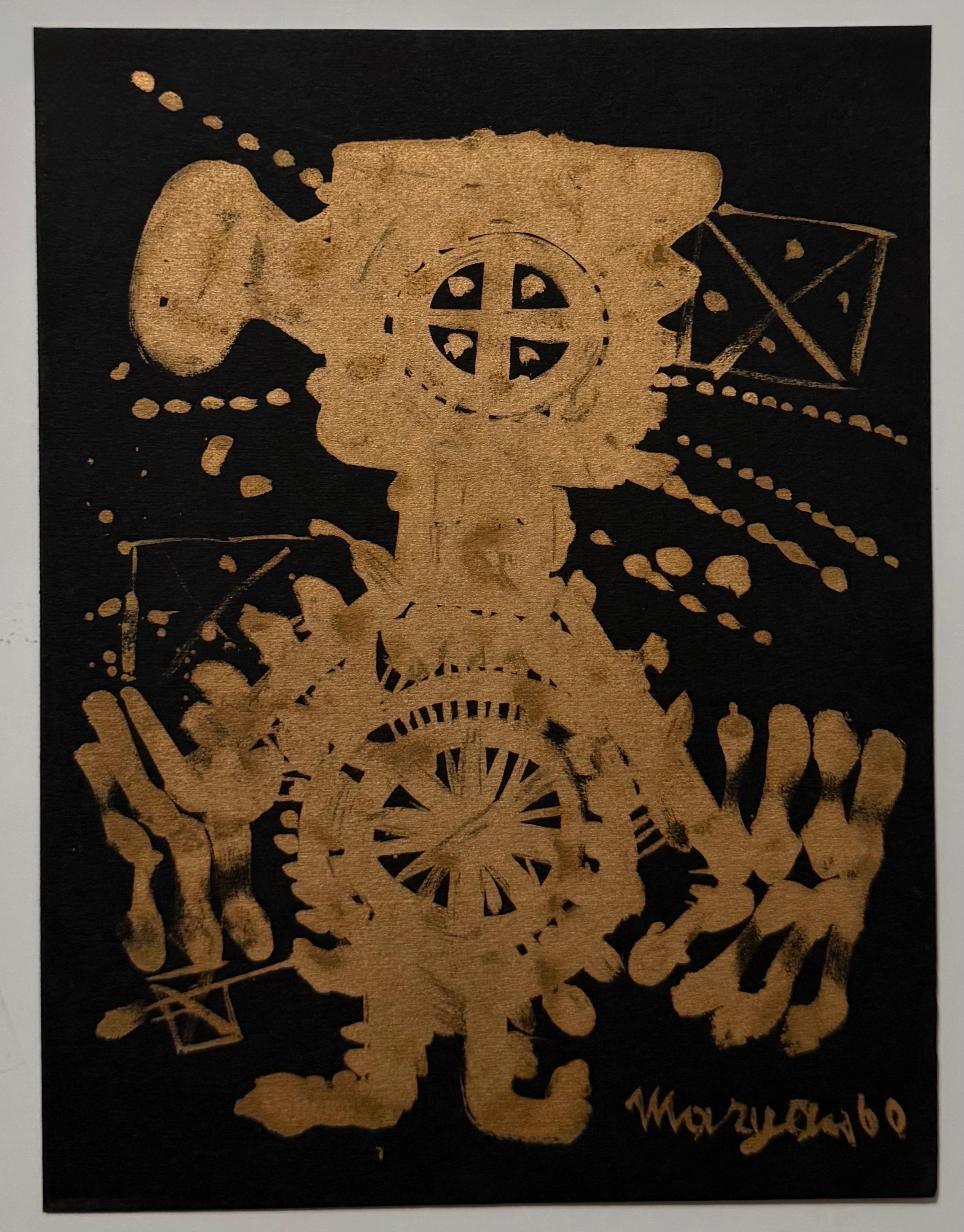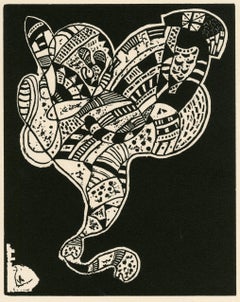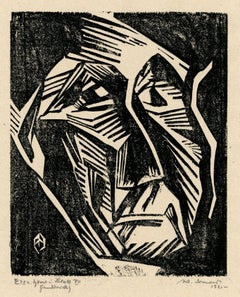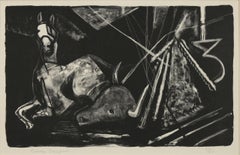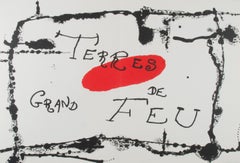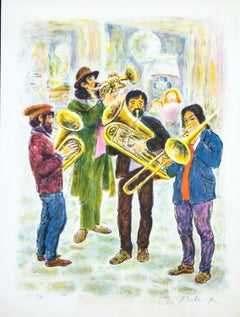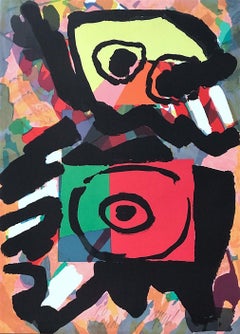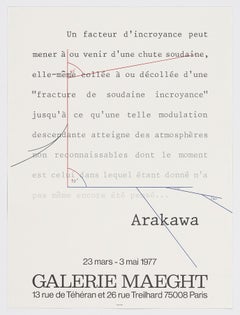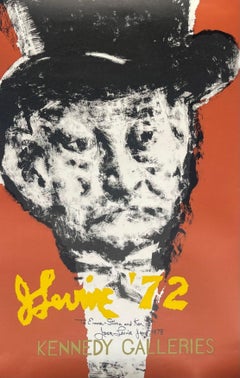Items Similar to Nightfear
Want more images or videos?
Request additional images or videos from the seller
1 of 11
Karel AppelNightfear1958
1958
About the Item
Nightfear
Color lithograph, 1958
From: Rhapsodie de ma nuit, (seven plates)
Signed, dated and numbered in pecnil lower left (see photos)
Edition: E.A. edition of 25, (there were also 75 impressions numbered)
Condition: Excellent, fresh colors and condition
Thin spots on reverse from previous hinges
Provenance: Martha Jackson Gallery
David Anderson Gallery
David Anderson granndchildren Trust
References And Exhibitions:
This portfolio is considered to be one of the greatest-and rarest-illustrated book of the Cobra movement. A copy of this livre d’artiste is in the collection of MOMA. This lithograph is one of four works in color in the portfolio. The book was authored by Emmanuel Looten and published by S.I. (Paris).
VERY IMPORTANT EARLY COBRA WORK OF ART
Karel Appel
B. 1921, AMSTERDAM; D. 2006, ZURICH
Karel Appel was born on April 25, 1921, in Amsterdam. From 1940 to 1943 he studied at the Rijksakademie van Beeldende Kunsten, Amsterdam. In 1946 his first solo show was held at Het Beerenhuis, Groningen, Netherlands, and he participated in Jonge Schilders (Young painters) at the Stedelijk Museum, Amsterdam. About this time, Appel was influenced first by Pablo Picasso and Henri Matisse, then by Jean Dubuffet. He was a member of the Nederlandse Experimentele Groep (Dutch Experimental Group, 1948) and established the Cobra group (1948–51) with Constant (Constant Nieuwenhuys), Corneille (Guillaume Cornelis Beverloo), and other painters from Copenhagen, Brussels, and Amsterdam. The style distinguished itself through bold, expressive compositions inspired by folk and children's art, as well as by the work of Paul Klee and Joan Miró. In 1949 Appel completed a fresco for the cafeteria of the city hall in Amsterdam, which created such controversy that it was covered for ten years.
In 1950 the artist moved to Paris; there the writer Hugo Claus introduced him to art critic Michel Tapié, who organized various exhibitions of his work. Appel was given a solo show at the Palais des beaux-arts, Brussels, in 1953. He received the UNESCO Prize at the 1954 Venice Biennale and was commissioned to execute a mural for the restaurant of the Stedelijk Museum in 1956. The following year Appel traveled to Mexico and the United States and won a graphics prize at the Ljubljana Biennial in Yugoslavia. The first major monograph on Appel, written by Claus, was published in 1962. In the late 1960s, the artist moved to the Château de Molesmes, near Auxerre, southeast of Paris. Solo exhibitions of his work were held at the Centre national d'art contemporain, Paris, and the Stedelijk Museum (1968), and at the Kunsthalle Basel and the Palais des beaux-arts (1969). During the 1950s and 1960s he executed numerous murals for public buildings. A major Appel show opened at the Centraal Museum, Utrecht, Netherlands (1970), and a retrospective toured Canada and the United States (1972).
In the 1970s and 1980s, Appel continued to work simultaneously in sculpture and painting, pushing his abstraction further with his window paintings—a series he began in 1980. Appel also gradually introduced landscape into his iconography, which would develop into a more consistent engagement in the last decade of his work. In the 1980s, Appel also began his collaborations with American poet Allen Ginsberg, which would continue over the next ten years. In his later career, his work was the subject of numerous solo exhibitions organized by Museum Boijmans Van Beuningen, Rotterdam (1982); Castello di Rivoli–Museo d'arte contemporanea, Turin, Italy (1987); National Museum of Art, Osaka (1989); Stedelijk Museum (1998, 2000, and 2001); and Cobra Museum voor Moderne Kunst, Amstelveen, Netherlands (2001). Appel died on May 3, 2006, in Zurich."
Courtersy Guggenheim
- Creator:Karel Appel (1921 - 2006, Dutch)
- Creation Year:1958
- Dimensions:Height: 10.13 in (25.74 cm)Width: 12.94 in (32.87 cm)
- Medium:
- Movement & Style:
- Period:
- Condition:
- Gallery Location:Fairlawn, OH
- Reference Number:Seller: FA108631stDibs: LU14014779862
Karel Appel
Karel Appel was a founding member of COBRA, an art movement originating in Germany that strived to replicate and invoke the child’s approach to art. Within this movement he created abstracted and simplified figures, often monsters and fractured depictions of people.
About the Seller
5.0
Recognized Seller
These prestigious sellers are industry leaders and represent the highest echelon for item quality and design.
Platinum Seller
Premium sellers with a 4.7+ rating and 24-hour response times
Established in 1978
1stDibs seller since 2013
785 sales on 1stDibs
Typical response time: <1 hour
Associations
International Fine Print Dealers Association
- ShippingRetrieving quote...Shipping from: Fairlawn, OH
- Return Policy
Authenticity Guarantee
In the unlikely event there’s an issue with an item’s authenticity, contact us within 1 year for a full refund. DetailsMoney-Back Guarantee
If your item is not as described, is damaged in transit, or does not arrive, contact us within 7 days for a full refund. Details24-Hour Cancellation
You have a 24-hour grace period in which to reconsider your purchase, with no questions asked.Vetted Professional Sellers
Our world-class sellers must adhere to strict standards for service and quality, maintaining the integrity of our listings.Price-Match Guarantee
If you find that a seller listed the same item for a lower price elsewhere, we’ll match it.Trusted Global Delivery
Our best-in-class carrier network provides specialized shipping options worldwide, including custom delivery.More From This Seller
View AllPlate 12
By Wassily Kandinsky
Located in Fairlawn, OH
Plate 12
From: 10 Origi, 1942
Signed in the block with the artist's initials lower left (printed)
From: 10 Origin
Not from the First edition 100, published by Allianz-Verlag, Zurich,...
Category
1970s Expressionist Abstract Prints
Materials
Woodcut
Ecce Homo VII
By Werner Drewes
Located in Fairlawn, OH
Ecce Homo VII
Woodcut, 1921
Signed, titled, and dated in pencil by the artist
One of only three known impressions
Created while the artist was studying at the Bauhaus in Weimar, Germany.
Extreme rarity-One of three know impressions
Note: In 1921 Drewes went to the Bauhaus in Weimar, where, after completing the compulsory preliminary course with Johannes Itten, he continued to study with Paul Klee, Oskar Schlemmer and Georg Muche and initially went to the wall painting workshop. He then traveled extensively through Europe, North America and Asia. After returning to Germany in 1927, he went back to the Bauhaus, this time to his new location in Dessau, where he studied in the classes of László Moholy-Nagy and Wassily Kandinsky. He was one of the first artists to introduce the groundbreaking concepts of the Bauhaus School in the United States through his painting, printmaking, and teaching.
Condition: Excellent
Missing small voids in the upper margin from removal of the original hinges.
Image size: 9 7/8 x 8 3/16 inches
Reference: Rose 30
Provenance: From the estate of Drewes's teacher at the Bauhaus. During the pasot WW2 the professor lived in East Germany.
WERNER DREWES
1899-1985
Werner Drewes initially studied architecture before enrolling, in 1921-22, at the Bauhaus in Weimar under Klee, Kandinsky, Itten and Feininger. For four years - 1923 to 1927 - he travelled the world with his bride, before completing his Bauhaus training in Dessau in 1929. He immigrated to the United States in 1930, documenting that move to New York through series of woodcuts. In 1936/37 he was an active founder of the American Abstract Artists and participated in the Federal Arts Project in New York before moving on to a teaching career at Washington University in St. Louis.
As an artist for over sixty five years, he employed various media from drawing and watercolor, through woodcut and etching, to painting and collage. Translating an early interest in subjective cubistic forms, his work evolved into nonobjective abstraction. He was creative until the day of his death.
Courtesy: Toby C. Moss
Werner Drewes (1899–1985) was a painter, printmaker, and art teacher. Considered to be one of the founding fathers of American abstraction, he was one of the first artists to introduce concepts of the Bauhaus school within the United States. His mature style encompassed both nonobjective and figurative work and the emotional content of this work was consistently more expressive than formal. Drewes was as highly regarded for his printmaking as for his painting. In his role as teacher as well as artist he was largely responsible for bringing the Bauhaus aesthetic to America.
Early life and education
Drewes was born in 1899 to Georg Drewes, a Lutheran pastor, and Martha Schaefer Drewes. The family lived in the village of Canig within Lower Lusatia, Germany. From age eight to eighteen he attended the Saldria Gymnasium, a boarding school in Brandenburg an der Havel. There, he showed talent both for painting and woodblock printing. Graduating from Saldria in 1917, he was drafted by the German army and served in France from then until the close of the war. About this period of his life he is reported to have said that the horrors of life at the front were only made tolerable by his sketchbook, a copy of Goethe's Faust and a volume of Nietzsche.
For a decade following the close of the war he studied, made paintings and prints, and traveled widely. His friend, Herwarth Walden, helped shape his appreciation for expressionist literature and art. Walden produced the quarterly magazine, Der Sturm and ran a gallery of contemporary art, Galerie Der Sturm, from which, in 1919, Drewes purchased an expressionist painting by William Wauer titled Blutrausch (Bloodlust). In the same year he made the acquaintance of Heinrich Vogeler and participated in Vogeler's socialist utopian artists' commune, Barkenhoff, at Worpswede, Lower Saxony. In 1919 Drewes also enrolled at the Königlich Technischen Hochschule Charlottenburg to study architecture and the following year he studied the same subject at the Technischen Hochschule Stuttgart. Preferring art over architecture, he then enrolled in Stuttgart's school of applied arts (Kunstgewerbeschule) where he studied life drawing and learned to work with colored glass. At this time he joined a group of artists and architects associated with the newly formed Merz Akademie, a college of design, art, and media in Stuttgart.
In 1921 his friendship with a French artist, Sébastien Laurent, led him to begin studies in Weimar at Bauhaus, then a new school which taught an integrated approach to the fine and applied arts. His instructors were Johannes Itten and Lyonel Feininger, whose paintings were expressionist and abstract, and Paul Klee, who taught bookbinding, stained glass, and murals. While at Bauhaus Drewes produced a portfolio of ten woodblock prints entitled "Ecce Homo."
In 1923 and 1924 he studied art during travels throughout Italy, Spain, the United States, and Central America and in 1926 he traveled to San Francisco, Japan, and Korea, thence taking the Trans-Siberian railway to Manchuria, Moscow, and Warsaw. He later said the El Grecos he saw proved to be most influential in his work. While traveling, he exhibited: (1) etchings in Madrid (1923) and Montevideo (1924), oils and etchings in Buenos Aires and St. Louis (1925), and (3) etchings in San Francisco (1926). He paid his way by the sales these exhibits produced and by taking commissions to paint portraits. While in San Francisco he set up a shop from which he sold prints he had made in Spain and South America.
After his return to Germany in 1927 he resumed study at Bauhaus, which had been forced to relocate in Dessau, Saxony-Anhalt. His instructors at that time were László Moholy-Nagy (metal work), Wassily Kandinsky, and (painting), and Lyonel Feininger (prints). At this time he also worked and exhibited in Frankfurt. With the rise of Nazism abstract artists found it increasingly difficult to sell their work and, in 1930, Drewes, finding the political pressure unbearable, emigrated to the United States. There, despite the world economic crisis, Drewes was able to earn a living as a professional artist.
Mature style
After Drewes moved to New York, Kandinsky, who was both friend and mentor, continued to exert a strong influence over his style. Later in life he said he had a hard time getting away from Kandinsky's influence as he developed his own style. In time he was able to bring a more emotional approach to his work and to base it, more than Kandinsky did, on natural forms.
In 1930 Drewes had a solo exhibition at the 135th Street Branch of the New York Public Library and a two-person show at the S.P.R. Penthouse Gallery...
Category
1920s Expressionist Abstract Prints
Materials
Woodcut
Toro and Horse
By Ralston Crawford
Located in Fairlawn, OH
Toro and Horse
Lithograph, 1957
Signed and numbered in pencil by the artist.
Titled in pencil lower left.
Edition: 25 (24/25)
Printer: Ravel, Paris
Reference: Freeman L57.11
'Toro and Horse' was inspired by Spanish bullfighting...
Category
1950s Cubist Prints and Multiples
Materials
Lithograph
Terres de Grand Feu, (Land of Great Fire)
By Joan Miró
Located in Fairlawn, OH
Derriere le miroir, no. 87-88-89. Pages 6-7
Terres de Grand Feu, (Land of Great Fire)
Color lithograph, 1956
From: Derriere le Miroir, Volume 87-8...
Category
1950s Abstract Abstract Prints
Materials
Lithograph
Untitled Double Page Illustration for DLM
By Alexander Calder
Located in Fairlawn, OH
Untitled Double Page Illustration for DLM
Color lithograph, 1968
Unsigned as issued in DLM
Published in Derriere le Miroir (Behind the Mirror), calle...
Category
1960s American Modern Abstract Prints
Materials
Lithograph
El Ultimo viaje del buque fantasma, Plate X
By Wifredo Lam
Located in Fairlawn, OH
El Ultimo viaje del buque fantasma, Plate X
Color lithograph, 1976
Signed in pencil lower right corner (see photo)
From: Gabriel Garcia Marquez, El Ultimo viaie del buque Fantasma
(The Last Voyage of the Ghost Ship (1868), 12 illustration by Wilfredo Lam
Edition: 99 (6/99)
This one of an edition of 99 from the delixe edition of the book of the same title
There was an additional edition of 200 books, signed and numbered on the justification page
Publisher: Poligrafa, Barcelona
Printer: Poligrafa, Barcelona
The Gabriel Garcia Marquez/Lam book is an illustrated version of the short story, a man recalls the night during his boyhood when an enormous passenger ship went aground in his small town on the shores of the Caribbean. It is considered a Latin American masterpiece of surrealism and transculturation. (See below analysis of the story)
Sheet size: 29 7/8 x 22 inches
Condition: Very fresh colors and condition
Slight scuffing verso from previous hinges
Reference: Lam-Tonneau-Ryckelnck CR360
About the author and the storyline of the book by Marquez:
Gabriel García Márquez was born in 1927, he is a famous Colombian writer, novelist, short story writer, screenwriter and journalist. In 1982 he received the Novel Prize for Literature. He is an author sometimes inherently related to magical realism and his best-known work is the novel One Hundred Years of Solitude...
Category
1970s Surrealist Abstract Prints
Materials
Lithograph
$1,575 Sale Price
30% Off
You May Also Like
Street Musicians by Ira Moskowitz original lithograph
By Ira Moskowitz
Located in Paonia, CO
Street Musicians by Ira Moskowitz shows four musicians playing various horn instruments including trumpets and trombones. Behind them some childre...
Category
20th Century Expressionist Figurative Prints
Materials
Lithograph
MULTI PERSONAGE Signed Lithograph, Abstract Collage Portrait, CoBrA Artist
By Karel Appel
Located in Union City, NJ
MULTI PERSONAGE is an original limited edition lithograph by the Dutch artist Karel Appel, printed using hand lithography techniques on archival Arches paper, 100% acid free. MULTI PERSONAGE is a lively abstract color collage portrait expressed in vibrant shades of red, blue, pink, green, purple, yellow with hints of multi color pastel tones and white creating an abstracted body and face. Bold black paint strokes define the face with its zany black eyes, head, body and limbs; collage effect torn paper bits fill in the body form. MULTI PERSONAGE is a very unique, fantastically playful and wild composition by Karel Appel, one of the founders of the avant-garde art movement CoBrA active during the late 1940's thru early 1950's. His paintings are known for incorporating applications of vibrant, violent colors often possessing a primal, childlike quality.
Print size - 30 x 20 inches, unframed, excellent condition, pencil signed by Karel Appel
Edition size - 175
Year published - 1980
Printer - JK Fine Art Editions Co., NY
Karel Appel was one of the founders of the avant-garde art movement CoBrA, active during the late 1940's thru early 1950's. His paintings are known for incorporating applications of vibrant, violent colors often possessing a primal, childlike quality.
Karel Appel, (born April 25, 1921, Amsterdam, Netherlands—died May 3, 2006, Zürich, Switzerland), Dutch painter of turbulent, colorful, and semi-abstract compositions, who was a co-founder (1948) of the CoBRA group of northern European Expressionists. He was also a noted sculptor and graphic artist.
Appel attended the Royal Academy of Fine Arts, Amsterdam (1940–43), and helped found the “Reflex” group, which became known as CoBRA (for Copenhagen, Brussels, and Amsterdam), in 1948. He moved to Paris in 1950 and by the 1960s had settled in New York City; he later lived in Italy and Switzerland. Partly in reaction against what they perceived as the sterile academicism of the de Stijl movement, the CoBRA artists...
Category
1980s Expressionist Portrait Prints
Materials
Lithograph
Shusaku Arakawa Japanese Artist 1977 original vintage poster lithograph print
By Shusaku Arakawa
Located in Miami, FL
Shusaku Arakawa (Japan, 1936-2010)
'Galerie Maeght', 1977
Original poster from exhibition of 1977
lithograph on paper
23.7 x 17.8 in. (60 x 45 cm.)
Unframed
Ref: ARA100-201
Shusaku ...
Category
1970s Expressionist Abstract Prints
Materials
Lithograph
Vintage 1970s Kennedy Galleries poster, Hand signed & warmly inscribed by artist
By Jack Levine
Located in New York, NY
Jack Levine
Vintage 1970s Kennedy Galleries poster (Hand signed and warmly inscribed), 1972
Offset lithograph poster (Signed, dated and inscribed in black marker by Jack Levine)
Sign...
Category
1970s Expressionist Portrait Prints
Materials
Lithograph, Offset
Günther Förg German Artist 1995 Original Poster lithograph
By Günther Förg
Located in Miami, FL
Günther Förg (Germany, 1952-2013)
'Erker-Gallery', 1995
Original poster from exhibition of 1995
lithograph on paper
36.5 x 22.6 in. (92.7 x 57.4 cm.)
Unframed
Ref: FOR100-201
Günthe...
Category
1990s Expressionist Abstract Prints
Materials
Lithograph
Polish French Figurative Abstract Art Brut Expressionist Lithograph Maryan
By Pinchas Maryan
Located in Surfside, FL
Pinchas Burstein, known as Maryan
Lithograph (after the drawing).
1960
Dimensions: 12 3/8 x 9 3/8 inches (315 x 240mm).
Gold or bronze ink on black paper
Signed in the plate, not b...
Category
1960s Expressionist Figurative Prints
Materials
Paper, Lithograph
Recently Viewed
View AllMore Ways To Browse
Chanel Pencil Case
Christine Joy Willow
Christopher John Rogers
Chrome Hearts Teddy
Clay Pottery Made By D F
Co Working Space Albert Park
Columbian Hardware
Community South Seas Service 12
Compassion Chris Levine
Constable The Cornfield
Conzett And Huber
Cora Wright
Cretan Pottery
Cyril Jones
Cyrus Leroy Baldridge
Dali Bronze Christ John Cross
Dali Cervantes
Dali Franklin
